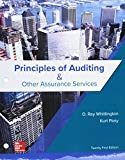
Concept explainers
Western Trading Company is a sole proprietorship engaged in the grain brokerage business. On December 31, 20X0, the entire grain inventory of the company was stored in outside bonded warehouses. The company’s procedure of pricing inventories in these warehouses includes comparing the actual cost of each commodity in inventory with the market price as reported for transactions on the commodity exchanges at December 31. A write-down is made on commodities in which cost is in excess of market. During the course of the 20X0 audit, the auditors verified the company’s computations. In addition to this, they compared the book value of the inventory with market prices at February 15, 20X1, the last day of fieldwork. The auditors noted that the market prices of several of the commodities had declined sharply subsequent to year-end, until their market price was significantly below the commodities’ book values.
The inventory was repriced by the auditors on the basis of the new market prices, and the book value of the inventory was found to be in excess of market value on February 15 by approximately $21,000. The auditors proposed that the inventories be written down by $17,000 to this new market value, net of gains on the subsequent sales. The management protested this suggestion, stating that in their opinion the market decline was only temporary and that prices would recover in the near future. They refused to allow the write-down to be made. Accordingly, the auditors qualified their audit opinion for a departure from generally accepted accounting principles.
Required:
- a. Were the auditors justified in issuing a qualified opinion in this situation? Discuss fully, including alternative courses of action.
- b. State your opinion as to the course of action that was appropriate this situation.
Want to see the full answer?
Check out a sample textbook solution
Chapter 12 Solutions
GEN COMBO LL PRINCIPLES OF AUDITING & OTHER ASSURANCE SERVICES; CONNECT AC
 Financial AccountingAccountingISBN:9781337272124Author:Carl Warren, James M. Reeve, Jonathan DuchacPublisher:Cengage Learning
Financial AccountingAccountingISBN:9781337272124Author:Carl Warren, James M. Reeve, Jonathan DuchacPublisher:Cengage Learning
